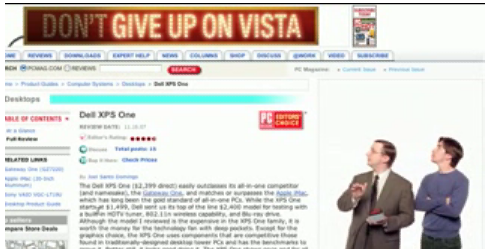As a person who has to understand the daily life of non-professional computer users, I always gladly suffer through the pains of those who purchase the right away the new operating systems and the computers based on them as soon as they come out. That is what I also did at the beginning of the year with Vista, and went into a major chain to buy a high end notebook, with a dual core processor, and 2 GB of RAM. And Vista… oh, yes.
Now, after using it for about six months I am a happy, proud, and very forthcoming user of a brand new Mac Book Pro. With a dual core processor, 2 GB of RAM. And OS X Leopard. Oh yeah…
So what happened? Microsoft Windows Vista really convinced me. I had enough!
- Q1 How can a system right out of the box refuse to play its own high definition demonstration videos, because I “don’t have the appropriate rights”?!
- Q2 How is it possible that after using Windows machines since when they didn’t know you could overlap windows on the screen (ie version 1.0), I became lost in the naming of control panel elements, and could not find what I wanted right away?
- Q3 How is it possible that I could not quickly configure a normal network, share the connection?
- Q4 And maybe most of all, how is it possible that a powerful machine like the one I bought, would bog down for 20-30 seconds each time I would switch from an application like the browser to the file manager, and display “Not responding” on the screen until finally it woke up?
There could be many answers. Here are mine:
- A1 This is just plain dumb, and paranoid. What harm can there be, even if I stole 30 seconds of demonstration video?
- A2 Inconsistent naming, compunded with a localization that doesn’t inherit the little logic the origical might have had, wants expert users to relearn terminology that shouldn’t.
- A3 Security becoming paranoia again, with a system that while still vulnerable to malware, is almost impossible to administer for very normal tasks.
- A4 When the user is the most feared enemy, the one whose actions the system has to guard itself against, lest sacred intellectual property is compromised, no power is spared to make sure that this doesn’t happen. And if there is little power left to execute the task the user needed the system for in the first place, the user be damned.
How did I make the switch? It was very easy.
I used Wakoopa, a software usage tracking application with a web based reporting system, that clearly told me what my dependencies were, and let me understand what I would and would not be able to do once I went over to the Mac, and also what eventual alternatives I could find if needed.
It was easy to see that almost everything I did on the Windows machine would be the same with the Mac. Firefox, Skype, OpenOffice.org, VLC media player, iTunes, Google Earth among other are identical on the two platforms. Other could be easily substituted with equivalent or better ones, like Picasa for photo editing with iPhoto, and PowerDirector for video editing with iMovie. The single most important application that I lost for the moment is Dragon NaturallySpeaking for speech recognition, which I used a lot for dictating longer documents. I am planning to use it with Parallels, or VMware Fusion. Until there is a native dictation product for the Mac.
I didn’t take objective measurements, but my guess is that my productivity at least doubled. Almost no rebooting, no freezing, no watching the screen until the OS unlocks. No virus scares or spyware (for the moment, but I am alert, and eventually will take measures if sense that the numbers of Macs around become a desirable target for criminals to exploit). The integrated iLife software alone is worth buying the machine!
Since then I had the two notebooks downgraded from Vista to XP. (It happens that they also broke…)
I am now planning to buy at least three-four additional Mac notebooks to be used in the family, and at work.

